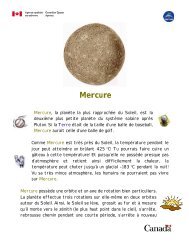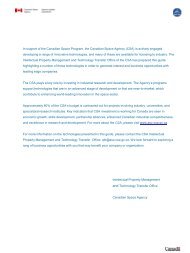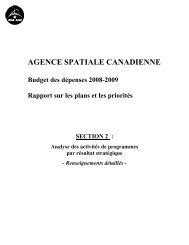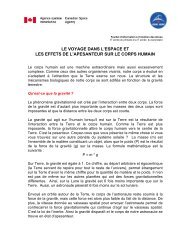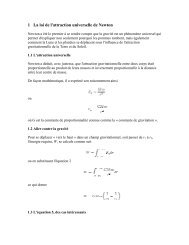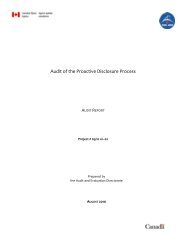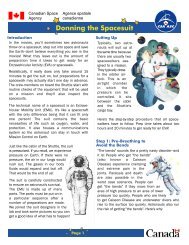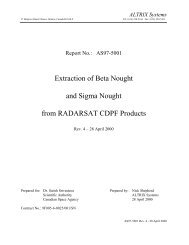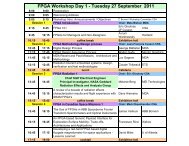PDF version of COSPAR - Space Science Research in Canada Report
PDF version of COSPAR - Space Science Research in Canada Report
PDF version of COSPAR - Space Science Research in Canada Report
You also want an ePaper? Increase the reach of your titles
YUMPU automatically turns print PDFs into web optimized ePapers that Google loves.
poles dur<strong>in</strong>g periods when it would experience 24-hour sunlight. This is whyBLAST was launched from McMurdo <strong>in</strong> December 2006. In June 2005, aprevious five-day BLAST mission was launched over the Arctic from Sweden forthe same reason.BLAST’s primary goal was to study starburst galaxies, where star formationoccurs at a dramatic pace. These galaxies are important <strong>in</strong> understand<strong>in</strong>g thestructure and evolution <strong>of</strong> the universe. To f<strong>in</strong>d them, BLAST must observe atsub-millimetre wavelengths. Located between the <strong>in</strong>frared and microwaveregions <strong>of</strong> the electromagnetic spectrum, these wavelengths provide a w<strong>in</strong>dowthrough clouds <strong>of</strong> dust that hide the star-form<strong>in</strong>g areas <strong>of</strong> galaxies from othertypes <strong>of</strong> telescopes, such as optical telescopes that observe wavelengths <strong>in</strong> thevisible range.Netterfield said that galaxies are filled with dust. “The stars are produc<strong>in</strong>g carbonfrom hydrogen and helium and just spew<strong>in</strong>g it out.” This dust plays an essentialrole <strong>in</strong> further star formation, he noted. In order for a star to form, a cloud <strong>of</strong> gasmust collapse under its own gravity so it becomes dense enough to start nuclearfusion, the stellar power source. This will not happen unless the gas cools down.“A really excellent way to cool the gas is to have it mixed with dust,” saidNetterfield. Dust radiates heat away, cool<strong>in</strong>g both itself and the gas it lives <strong>in</strong>,enabl<strong>in</strong>g the gas to collapse enough to form a star. “You always f<strong>in</strong>d starformation buried <strong>in</strong> dust clouds.”Unfortunately, he noted, the dust “also masks everyth<strong>in</strong>g beh<strong>in</strong>d it. You can’t seethrough it <strong>in</strong> visible light.” Thus, it blocks the view <strong>of</strong> conventional telescopes.BLAST, however, can pierce right through the dust and can also measure itsproperties and behaviour. Sub-millimetre telescopes can reveal what is go<strong>in</strong>g onby measur<strong>in</strong>g the temperature <strong>of</strong> the surround<strong>in</strong>g dust cloud, which is warmed bythe process <strong>of</strong> star formation. By measur<strong>in</strong>g the average temperature <strong>of</strong> the dust,scientists can estimate “the total power emitted by the new, bright, short-livedstars and therefore the rate <strong>of</strong> star formation,” Netterfield said.BLAST provides a new w<strong>in</strong>dow on star formation “from relatively nearby stellarnurseries to the most extreme star-burst<strong>in</strong>g galaxies, at ages most <strong>of</strong> the wayback to the beg<strong>in</strong>n<strong>in</strong>g <strong>of</strong> time,” said UBC pr<strong>of</strong>essor Douglas Scott, anothermember <strong>of</strong> the BLAST team. “This has been an extraord<strong>in</strong>ary flight and the datawill be very excit<strong>in</strong>g.”Another key purpose <strong>of</strong> the BLAST program is to pave the way for the European<strong>Space</strong> Agency’s Herschel <strong>Space</strong> Observatory, a telescope scheduled for launch45



